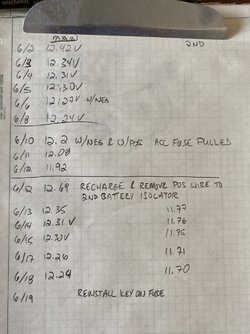T
Thanks. Performed the test on both main and second batteries and no spark. I’m looking at my data again (pic above) and it looks like I have a sort of consistent drop in voltage on my main battery no matter what. Do I just have a bad battery? We bought the machine in 2019. I’ve heard stories of bad batteries from around that time.
Please note that this "test" will not result in a spark, even with a new fully charged battery, IF there is no load (significant current) being drawn from the battery, as removing and reconnecting the battery lead will not start or stop current flow! It's true, it will result in a visible spark when there is a load, but the size of the spark would be predicated on the amount of current flow which would vary both with the size of the load and condition of the battery.
This also means that if an accessory isn't on and drawing significant current, pulling and replacing the fuse will not result in a spark, good battery or bad.
If you don't have a voltmeter to check voltage while cranking (should be more than 10 volts), or a panel volt meter that may be useful (but some won't display voltage while cranking) it will show voltage when you turn on headlight - voltage would normally drop, but not below 12 volts, and then start to recover a bit.
To check for "phantom" current draw, the best way to test is with an amp meter (most digital volt meters have that function too). To test you would do as
@Scoop suggests, remove negative lead from battery and insert the meter leads between the battery post and the wire removed. (Note that most meters will have a current limit of 10 amps - but follow directions on or with meter.) On some vehicles there will be a small amount of current draw to "keep alive" device memory. That will using be a few milliamps, so won't drain a battery much quicker than the self-discharge that occurs with lead acid batteries of about 5% per month.

















